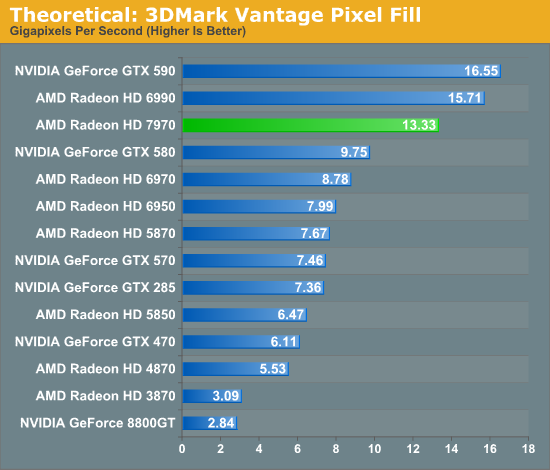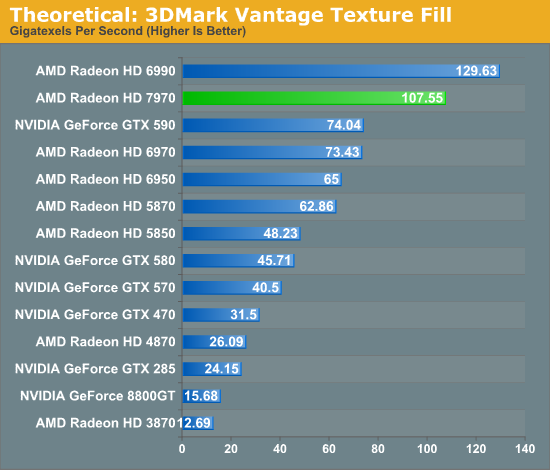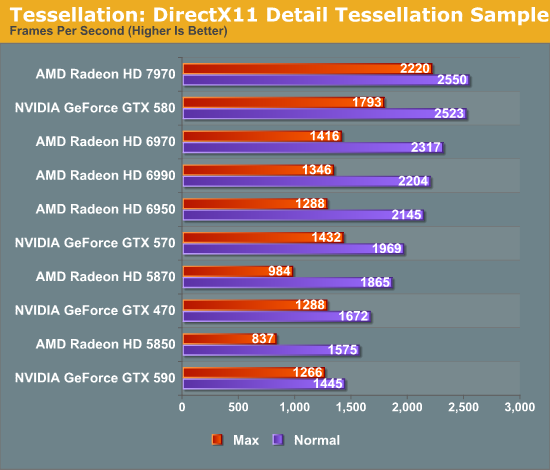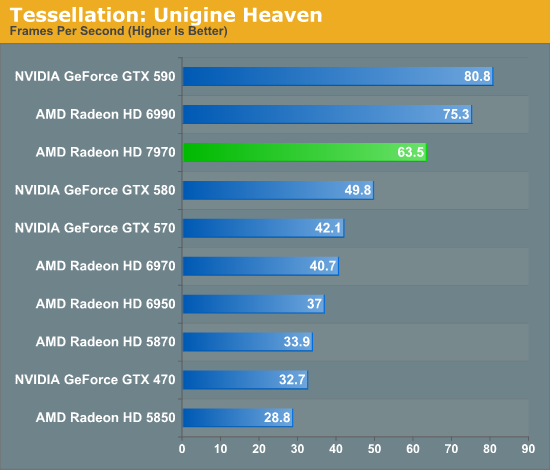AMD Radeon HD 7970 Review: 28nm And Graphics Core Next, Together As One
by Ryan Smith on December 22, 2011 12:00 AM EST- Posted in
- GPUs
- AMD
- Radeon
- ATI
- Radeon HD 7000
Theoreticals & Tessellation
From a rendering perspective one of the most interesting things AMD did with Tahiti was what they didn’t do: they didn’t add more ROPs, they didn’t add more geometry engines. And yet based on our game performance they’ve clearly improved on their performance in those situations by making more efficient use of the hardware they do have.
So we wanted to take a quick look at synthetic performance to see what these tools had to say about AMD’s changes. We’ve included the numbers for every other GPU in our lineup as a reference point, but we would strongly suggest against reading into them too much. AMD versus AMD is sometimes relevant to real world performance; AMD versus NVIDIA rarely is.

We’ll start with 3DMark Vantage and its color fill test. This is basically a ROP test that attempts to have a GPU’s ROPs blend as many pixels as it can. Theoretically AMD can do 32 color operations per clock on Tahiti, which at 925MHz for 7970 means the theoretical limit is 29.6Gpix/sec; not that any architecture is ever that efficient. In practice 7970 hits 13.33Gpix/sec, which is still well short of the theoretical maximum, but pay close attention to 7970’s performance relative to 6970. Even with the same number of ROPs and a similar theoretical performance limit (29.6 vs 28.16), 7970 is pushing 51% more pixels than 6970 is.
In designing Tahiti AMD said that they didn’t need more ROPs they just needed more efficient ROPs, and it looks like they’ve delivered on this. It’s not clear whether this is the limit for efficiency or if AMD can squeeze more out of their ROPs in future designs, but this definitely helps to prove that there’s more to graphics rendering than a large number of functional units.

Our other 3DMark synthetic benchmark is the 3DMark Vantage Texture Blend test, which measures how quickly a GPU can blend multiple FP16 textures. This is more synthetic than most tests because FP16 textures aren’t widely used, but it’s a consistent benchmark.
The theoretical performance improvement from 6970 to 7970 is 40% - 33% more texture units operating at a 5% higher clockspeed. In practice the 7970 exceeds that improvement by increasing texture performance by 46%, meaning the 7970 has benefitted from more than the increase in texture units. Most likely the new cache architecture has further improved the efficiency of the texture units, although the 3DMark texture set is not particularly large.
Moving on, we also wanted to take a look at tessellation. AMD did not increase the theoretical geometry performance of Tahiti as compared to Cayman – both top out at 2 triangles per clock – but AMD has put a lot of effort into improving the efficiency of Tahiti’s geometry units as we’ve seen reflected in our game benchmarks.

Our first tessellation benchmark is the traditional Detail Tessellation sample program from the DirectX SDK. Here we’re looking at tessellation performance as a product of the framerate, testing at tessellation factors 7 (normal) and 15 (max). Traditionally this is a test that has been rather balanced at normal tessellation levels, while NVIDIA cards with their superior geometry throughput have been the top performers at maximum tessellation levels. So it’s all the more interesting when we’ve seen the tables turned; the 7970 is merely competitive with the GTX 580 at normal tessellation levels, but now it’s ahead of the GTX 580 by 24%. More significantly however the 7970 is ahead of the 6970 by 57%.

Our second tessellation benchmark is Unigine Heaven, a benchmark that straddles the line between a synthetic benchmark and a real-world benchmark, as the engine is licensed but no notable DX11 games have been produced using it yet. In any case the Heaven benchmark is notable for its heavy use of tessellation, which means it’s largely a proxy test for tessellation performance.
As with the Detail Tessellation sample program, Heaven shows significant gains for the 7970 versus the 6970, with the 7970 leading by 56%. Meanwhile it leads the GTX 580 by 27%, which is actually slightly better than what we saw under the more “pure” Detail Tessellation sample. Between these two benchmarks it’s clear that AMD’s tessellation efficiency improvements are quite real, and that with Tahiti AMD can deliver much better tessellation performance than Cayman even at virtually the same theoretical triangle throughput rate.
Of course one has to wonder what NVIDIA will have in store for Kepler next year. Their current Fermi design seems to scale well with additional geometry units, but if Tahiti is anything to go by, there’s a great deal to be gained just by focusing on efficiency. NVIDIA has prided themselves on their geometry performance since before GF100 even shipped, so it will be interesting if they have anything in store to hold on to that distinction.










292 Comments
View All Comments
CeriseCogburn - Thursday, March 8, 2012 - link
Interesting, amd finally copied nvidia..." This problem forms the basis of this benchmark, and the NQueen test proves once more that AMD's Radeon HD 7970 tremendously benefits from leaving behind the VLIW architecture in complex workloads. Both the HD 7970 and the GTX 580 are nearly twice as fast as the older Radeons. "
When we show diversity we should also show that amd radeon has been massively crippled for a long time except when "simpleton" was the key to speed. "Superior architecture" actually means "simple and stupid" - hence "fast" at repeating simpleton nothings, but unable to handle "complex tasks".
LOL - the dumb gpu by amd has finally "evolved".
chizow - Thursday, December 22, 2011 - link
....unfortunately its going to be pitted against Kepler for the long haul.There's a lot to like about Southern Islands but I think its going to end up a very similar situation as Evergreen vs. Fermi, where Evergreen released sooner and took the early lead, but Fermi ultimately won the generation. I expect similar with Tahiti holding the lead for the next 3-6 months until Kepler arrives, but Kepler and its refresh parts winning this 28nm generation once they hit the streets.
Overall the performance and changes AMD made with Tahiti look great compared to Northern Islands, but compared to Fermi parts, its just far less impressive. If you already owned an AMD NI or Evergreen part, there'd be a lot of reason to upgrade, but if you own a Fermi generation Nvidia card there's just far less reason to, especially at the asking price.
I do like how AMD opened up the graphics pipeline with Tahiti though, 384-bit bus, 3GB framebuffer, although I wonder if holding steady with ROPs hurts them compared to Kepler. It would've also been interesting to see how the 3GB GTX 580 compared at 2560 since the 1.5GB model tended to struggle even against 2GB NI parts at that resolution.
ravisurdhar - Thursday, December 22, 2011 - link
My thoughts exactly. Can't wait to see what Kepler can do.Also...4+B transistors? mind=blown. I remember when we were ogling over 1B. Moore's law is crazy.... :D
johnpombrio - Wednesday, December 28, 2011 - link
Exactly. If you look at all the changes that AMD did on the card, I would have expected better results: the power consumption decrease with the Radeon 7970 is mainly due to the die shrink to 28nm. NVidia is planning on a die shrink of their existing Fermi architecture before Kepler is released:http://news.softpedia.com/news/Nvidia-Kepler-Is-On...
Another effect of the die shrink is that clock speed usually increases as there is less heat created at the lower voltage needed with a smaller transistor.
The third change that is not revolutionary is the bump of AMD's 7970's memory bus from 384 bits (matching the 580) from the 6970's 256 bits along with 3GB DDR5 memory vs the GTX580's 1.5GB and the 6970's 2GB.
The final non revolutionary change is bumping the number of stream processors by 33% from 1,536 to 2,048.
Again, breaking out my calculator, the 35% bump in the number of stream processors ALONE causes the increase in the change in the benchmark differences between the 7970 and the 6970.
The higher benchmark, however, does not show ANY OTHER large speed bumps that SHOULD HAVE OCCURED due to the increase in the memory bus size, the higher amount of memory, compute performance, texture fill rate, or finally the NEW ARCHITECTURE.
If I add up all the increases in the technology, I would have expected benchmarks in excess of 50-60% over the previous generation. Perhaps I am naive in how much to expect but, hell, a doubling of transistor count should have produced a lot more than a 35% increase. Add the new architecture, smaller die size, and more memory and I am underwhelmed.
CeriseCogburn - Thursday, March 8, 2012 - link
Well, we can wait for their 50%+ driver increase package+ hotfixes - because after reading that it appears they are missing the boat in drivers by a wide margin.Hopefully a few months after Kepler blows them away, and the amd fans finally allow themselves to complain to the proper authorities and not blame it on Nvida, they will finally come through with a "fix" like they did when the amd (lead site review mastas) fans FINALLY complained about crossfire scaling....
KaarlisK - Thursday, December 22, 2011 - link
What is the power consumption with multiple monitors? Previously, you could not downclock GDDR5, so the resulting consumption was horrible.Ryan Smith - Thursday, December 22, 2011 - link
"On that note, for anyone who is curious about idle clockspeeds and power consumption with multiple monitors, it has not changed relative to the 6970. When using a TMDS-type monitor along with any other monitor, AMD has to raise their idle clockspeeds from 350MHz core and 600Mhz memory to 350MHz core and the full 5.5GHz speed for memory, with the power penalty for that being around 30W. Matched timing monitors used exclusively over DisplayPort will continue to be the only way to be able to use multiple monitors without incurring an idle penalty."KaarlisK - Thursday, December 22, 2011 - link
Thank you for actually replying :)I am so sorry for having missed this.
ltcommanderdata - Thursday, December 22, 2011 - link
Great review.Here's hoping that AMD will implement 64-bit FP support across the whole GCN family and not just the top-end model. Seeing AMD's mobile GPUs don't use the highest-end chip, settling for the 2nd highest and lower, there hasn't been 64-bit FP support in AMD mobile GPUs since the Mobility HD4800 series. I'm interested in this because I can then dabble in some 64-bit GPGPU programming on the go. It also has implications for Apple since their iMacs stick to mobile GPUs, so would otherwise be stuck without 64-bit FP support which presumably could be useful for some of their professional apps.
In regards to hardware accelerated Megatexture, is it directly applicable to id Tech 5's OpenGL 3.2 solution? ie. Will id Tech 5 games see an immediate speed-up with no recoding needed? Or does Partially Resident Texture support require a custom AMD specific OpenGL extension? If it's the later, I can't see it going anywhere unless nVidia agrees to make it a multivendor EXT extension.
Ryan Smith - Thursday, December 22, 2011 - link
Games will need to be specifically coded for PRT; it won't benefit any current games. And you are correct in that it will require and AMD OpenGL extension to use (it won't be accessible from D3D at this time).